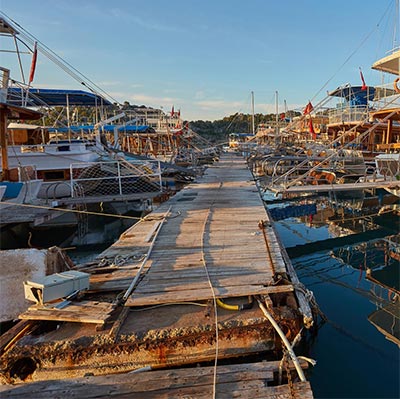Why Normal Upkeep Can Minimize Future Dock Repairs
Why Normal Upkeep Can Minimize Future Dock Repairs
Blog Article
Exactly How to Address Common Dock Repair Work Issues for Safe Water Tasks

Identifying Common Dock Issues
Determining typical dock issues is crucial for preserving the functionality and security of your waterside residential or commercial property. Normal examinations can assist discover problems before they become serious, making sure both the long life of the dock and the safety of those that utilize it.
Another usual trouble is the deterioration of flotation protection tools. These devices are essential for maintaining the dock resilient, and any damages or punctures can trigger the dock to list or sink. Frequently inspecting for leaks or waterlogged drifts can preempt a lot more considerable issues.
Furthermore, algae and barnacle accumulation on the dock's surface can produce unsafe and slippery problems. This biofouling not just poses a risk to users yet can additionally speed up the wear and tear of the dock materials.
Finally, inspecting for indications of rust on steel components is essential. Rust can endanger the honesty of the dock's structure, making it risky. By consistently recognizing these usual dock issues, you can ensure that your dock stays safe and secure and practical for several years ahead.
Repairing Rotting Wood
When attending to the problem of deteriorating wood on your dock, it is critical to act quickly to avoid additional degeneration. Begin by extensively inspecting the entire framework to identify all affected locations. Utilize a screwdriver to probe the timber; if it sinks in quickly, the wood is most likely decayed and needs immediate attention.
Once identified, remove the deteriorated sections utilizing a saw or sculpt. Make sure to cut back to healthy, solid timber, ensuring you get rid of all jeopardized material. After elimination, treat the continuing to be timber with a timber chemical to avoid future rot. This therapy will aid guard versus moisture, which is the key reason for timber decay.
Following, replace the gotten rid of sections with marine-grade lumber or pressure-treated timber, which are more immune to water damage. Secure the new items with stainless-steel or galvanized bolts to stop rust. Furthermore, using a waterproof sealer to the new timber can provide an extra layer of protection.
Protecting Loosened Boards
Exactly how do you ensure your dock stays safe and useful for all its customers? One vital element is securing loosened boards, which can or else pose substantial risks. Loosened boards not just enhance the risk of tripping yet can likewise jeopardize the architectural integrity of the whole dock.

For reinstallation, utilize stainless or galvanized steel screws, as these materials supply superior resistance to rust in aquatic atmospheres. Guarantee the screws are long sufficient to penetrate deep into the underlying support structure, yet not so lengthy that they stick out via the dock's surface. Pre-drilling pilot holes can aid stop the wood from splitting.
Lastly, keep a regular examination schedule to identify and deal with any type of brand-new issues without delay. By protecting loose boards successfully, you add to the general security and durability of your dock, making it a dependable system for water activities.
Stabilizing Unstable Pilings
Making sure the security of unstable pilings is critical to preserving a secure and practical dock. Use a degree to inspect for vertical positioning and ensure published here they are driven deep enough into the substrate to supply adequate support.
If the pilings are located to be unsteady, one reliable technique for support is making use of added bracing. Cross-bracing with treated lumber or galvanized metal can considerably enhance stability. Anchor the braces securely to both the pilings and the dock frame to distribute loads uniformly.

Routine maintenance and regular review of the pilings' security are vital to guaranteeing long-lasting dock security and functionality.
Replacing Rusty Equipment
Attending to unstable pilings is simply one facet of keeping a dock's stability; one more crucial worry is replacing rustic hardware. With time, exposure to moisture and salt can bring about the oxidation and rust of screws, braces, and screws, jeopardizing the whole structure's security. Regular evaluation for corrosion is vital, particularly after serious weather or seasonal adjustments.
When rusty equipment is recognized, immediate activity is called for. Begin by picking marine-grade stainless steel or galvanized hardware, both created to stand up to the severe aquatic environment. Make sure that you have the appropriate tools, such as wrenches and screwdrivers, to securely remove the old, rusty pieces without triggering more damage to the dock.
After removing the rusty hardware, thoroughly clean the affected areas to get rid of any type of recurring corrosion or debris. Apply a rust-inhibiting guide to revealed steel surface areas before setting up the brand-new equipment. Tighten all components safely to stop future helping to loosen, and regularly Full Article inspect the fittings to ensure ongoing security.
Replacing rusty hardware not just extends the dock's life expectancy however also significantly improves the safety of water activities. By proactively managing corrosion, you protect both the structure and its users, ensuring a enjoyable and secure waterfront experience.
Conclusion
Regular evaluations and upkeep are necessary to address typical dock repair service concerns and make certain safe water activities. Such aggressive steps add to the total security and functionality of dock structures, cultivating a protected setting for water-based activities.
Making certain the safety and security of water activities hinges substantially on the correct upkeep and repair of anchors (Dock Repairs). These tools are vital for keeping the dock buoyant, and any type of damage or slits can cause the dock to listing or sink. By consistently identifying these typical dock issues, you can make certain that your dock remains secure and practical for years to come
Making sure the security of unsteady pilings is critical to maintaining a risk-free and functional dock.Normal inspections and upkeep are essential to address common dock repair issues and make sure safe water activities.
Report this page